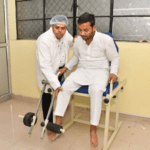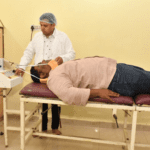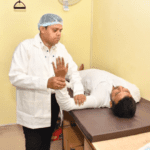Regain Shoulder Mobility with Simple Frozen Shoulder Exercises

Shoulders play an indispensable role in our daily lives, often overlooked until there’s a hitch in their function. Think about it. Ever swung a tennis racket with fervor, trying to hit the perfect serve? Or maybe, you’ve reached out, stretching to the fullest extent, trying to grab that elusive jar from the top shelf? And how many times have we casually waved to a friend across the street or in the park? All these seemingly trivial actions are possible due to the mobility and function of our shoulders.
But, can you truly fathom a life without this crucial shoulder mobility? A life where every simple action, like grabbing something or waving, becomes an excruciating task? It’s daunting to even consider, isn’t it? Unfortunately, this is the harsh reality for many who suffer from a condition known as a frozen shoulder. This ailment restricts the movement of the shoulder, causing pain and stiffness.
Now, the question is, is there a ray of hope for those suffering from this condition? The answer is a resounding yes. Frozen shoulder exercises are specifically designed to combat this issue, focusing on regaining lost mobility and reducing discomfort. These exercises are not complex gym routines but are simple movements that can be integrated into daily life. By consistently practicing these frozen shoulder exercises, individuals can gradually reclaim the free movement of their shoulders, returning to their normal routines without hindrance.
Moreover, it’s not just about remedying the issue, but prevention too. For those at risk or in the early stages, incorporating a regimen of frozen shoulder exercises can be a proactive approach to maintaining shoulder health. After all, why wait for the problem to become severe when it can be nipped in the bud?
In conclusion, while the shoulders are instrumental in many of our daily activities, their health shouldn’t be taken for granted. For those facing mobility issues due to a frozen shoulder, simple exercises can be the key to unlocking pain-free movement.
Also, read Dr. Sharad Gupta: The Best Physiotherapy in Kanpur
Frozen Shoulder Exercises: Alleviate Pain and Improve Flexibility

The human body is a marvel of engineering, with each part playing its distinctive role. But among the various joints and limbs, the shoulders arguably bear one of the most critical responsibilities. The significance of shoulder mobility cannot be stressed enough, especially considering the extensive range of movements they support.
Imagine the joyous moment of lifting a newborn baby to see their smile or the routine task of pushing a laden grocery cart down supermarket aisles. What about reaching out to hug a loved one or even the basic act of putting on a jacket? All these actions, and countless more, are facilitated by our shoulders. Frozen shoulder exercises become imperative when we recognize the plethora of tasks our shoulders perform.
However, like any machine’s cog, wear and tear, or in this case, ailments and injuries, can hinder its function. One such common ailment is adhesive capsulitis, more commonly known as frozen shoulder. It’s a condition characterized by pain and stiffness in the shoulder joint, leading to decreased mobility. When such a critical joint is compromised, it’s not just the physical pain that torments individuals; there’s also a psychological aspect as the simplest of tasks turns daunting.
Also, read Physiotherapy Exercises for Lower Back Pain | Dr Sharad Gupta
Frozen shoulder exercises

These are a series of carefully curated movements aimed at restoring the shoulder’s range of motion. They are not strenuous but rather gentle stretches and rotations designed to alleviate pain and regain mobility. By integrating these exercises into one’s daily routine, the journey from stiffness to fluidity becomes smoother.
Furthermore, with the help of LSI (Latent Semantic Indexing) keywords such as ‘joint health,’ ‘shoulder stretches,’ and ‘pain relief,’ it becomes evident that the digital age also acknowledges the importance of shoulder health.
In essence, shoulder mobility is not just about physical movement but the freedom to live life without constraints. As we go about our day, let’s remember to give our shoulders the care they deserve, employing frozen shoulder exercises when needed and ensuring their health for the long haul.
Also, read Exceptional Physiotherapeutic Care by Kanpur’s Dr. Sharad Gupta
What is a Frozen Shoulder?

Frozen shoulder, a term that might evoke images of extreme cold, actually refers to a painfully restrictive condition of the shoulder. Officially recognized in medical circles as “adhesive capsulitis,” this ailment is a cause of concern for many. As the name suggests, a frozen shoulder exercise results in the shoulder joint “freezing” or becoming extremely stiff. This rigidity significantly hampers mobility and is often accompanied by discomfort or pain.
Causes
So, what triggers this icy grip on one’s shoulder? A myriad of factors can lead to the onset of a frozen shoulder. One of the predominant causes is injury. Picture an athlete or even an average Joe, straining their shoulder muscles, leading to injury and subsequently resulting in the joint’s stiffness. Overuse is another significant factor. Repetitive motions, especially common in certain jobs or activities, can take a toll on the shoulder, leading to decreased flexibility.
Furthermore, health conditions play their part too. For instance, diseases like diabetes have been linked to a higher prevalence of frozen shoulders. Surprisingly, in some cases, frozen shoulder exercises might just creep up on an individual without a clear precipitating event or reason. It’s as if the shoulder decides to rebel, causing consternation.
Symptoms
Identifying frozen shoulder exercises isn’t rocket science, but understanding its symptoms can pave the way for early intervention. The most telling sign is a gradual onset of pain in the shoulder region. This pain progressively intensifies, making even minor shoulder movements a challenge. Following this, the pain might plateau or even diminish slightly, but the stiffness remains, resulting in markedly reduced shoulder movement.
Also, read Dr. Sharad Gupta: Solution to Sciatica in Kanpur
The Phases of Frozen Shoulder
A frozen shoulder isn’t a sudden ailment that strikes out of the blue. It’s a gradual, evolving condition that traverses through specific stages, each characterized by unique symptoms. Understanding these phases can be instrumental in determining the appropriate course of action and the effectiveness of interventions like frozen shoulder exercises.
1. Freezing Phase
This initial stage is aptly named, for it marks the onset of the condition. During this phase, individuals will start experiencing an increase in shoulder pain. Simple activities, like reaching for a book or combing hair, can become excruciating tasks. Alongside the escalating pain, there’s a noticeable decrease in the range of motion. The shoulder joint starts to lose its flexibility, making it harder to perform routine movements. Engaging in frozen shoulder exercises during this phase, under the guidance of a healthcare professional, can help mitigate the pain and curtail the loss of motion.
2. Frozen Phase
As the name suggests, during the frozen phase, the shoulder’s mobility reaches a near standstill. The silver lining here is that the intensity of pain might plateau or even reduce slightly. However, the stiffness persists, making the shoulder seem almost “locked” in place. This stage can be particularly challenging as daily activities get severely hampered. Yet, with consistent frozen shoulder exercises, it’s possible to maintain some degree of mobility and prepare the joint for the subsequent recovery phase.
3. Thawing Phase
Hope isn’t lost for those grappling with a frozen shoulder, for there’s a thawing phase. During this stage, the icy grip of stiffness starts to relent, and the shoulder gradually regains its movement. The pain further diminishes, and with the assistance of frozen shoulder exercises, the path to full recovery becomes clearer.
Key Benefits of Frozen Shoulder Exercises

In the world of physical rehabilitation, frozen shoulder exercises stand out as a beacon of hope for those grappling with adhesive capsulitis or, as it’s commonly known, frozen shoulder. These exercises aren’t just about moving your arms in different directions; they represent a holistic approach to healing and regaining one’s full range of motion. Let’s delve deeper into the myriad benefits these exercises offer.
1. Enhanced Range of Motion
One of the most debilitating aspects of a frozen shoulder is the restricted movement. This is where frozen shoulder exercises, especially stretching exercises, come to the rescue. By gently working the shoulder joint and surrounding muscles, these exercises facilitate a gradual increase in flexibility. Over time, tasks that once seemed herculean – like reaching out for an item on the top shelf – become effortless again.
2. Reduction in Pain
Persistent pain can be mentally and physically draining. Thankfully, the consistent practice of frozen shoulder exercises can play a pivotal role in pain management. These exercises target the inflamed areas, promoting blood flow and reducing stiffness, which in turn eases the pain.
3. Strengthening of Shoulder Muscles
It’s not just about flexibility; strength is of the essence too. Incorporating resistance and strengthening exercises can fortify the shoulder muscles. This not only aids in recovery but also acts as a preventive measure against potential future injuries.
4. Promotion of Better Posture
A healthy shoulder contributes significantly to overall posture. By engaging in frozen shoulder exercises, individuals can realign their posture, reducing the strain on the back and neck. This is particularly beneficial in today’s digital age, where many of us are prone to the pitfalls of poor posture.
5. Regaining Control
The psychological boost one feels when regaining mobility cannot be understated. The sense of reclaiming control over one’s body and life is indeed a bonus, giving individuals the confidence to face challenges head-on.
Simple Exercises to Improve Shoulder Mobility
A frozen shoulder can be a significant impediment to one’s daily life. However, the silver lining amidst this challenge is the array of frozen shoulder exercises designed to restore mobility and reduce pain. These exercises, if performed consistently, can gradually usher in better flexibility and strength. Here’s a closer look at some simple, yet effective exercises to get that shoulder back in action.
1. Pendulum Swings

A great starting point, the pendulum swing is all about gentle movements. To do this:
- Stand beside a table, ensuring stability.
- Lean slightly forward, allowing the affected arm to hang freely down.
- Begin by swinging the arm gently in small, circular motions. It’s almost like stirring a pot, but in mid-air!
- After a few minutes, switch directions, ensuring an even stretch.
2. Towel Stretch
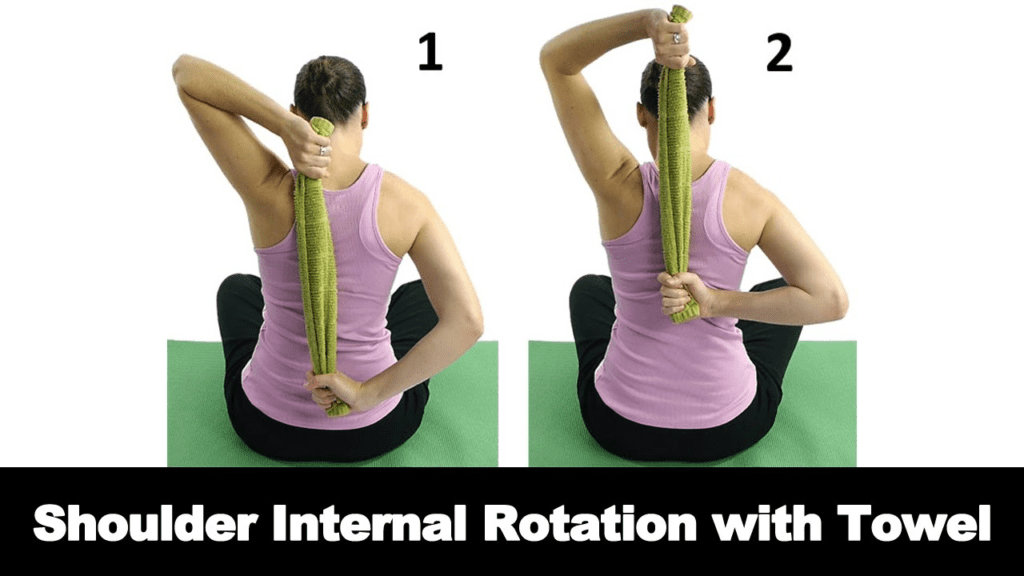
The towel stretch can feel wonderfully relieving:
- Hold a towel with both hands behind your back.
- With the unaffected arm, gently pull the affected arm upward, stretching the shoulder muscles in the process.
- It’s like trying to dry your back with a towel but with more emphasis on the stretch.
3. Cross-body Reach

This exercise aids in lateral stretching:
- Using the good arm, help the affected arm cross over your body.
- You’ll experience a stretch along the shoulder blade and side of the shoulder, a testament to its effectiveness.
4. Armpit Stretch

A slightly unconventional but rewarding stretch:
- Place the affected arm on a chair or low table, supporting it.
- Gradually squat down, focusing on stretching the armpit region.
5. External Rotation

Perfect for resistance and strength:
- Clasp a rubber exercise band between your hands.
- Keep your elbows bent at a 90-degree angle.
- Rotate the lower part of the affected arm outward, holding the position momentarily.
Safety Tips While Performing Frozen Shoulder Exercises
Engaging in frozen shoulder exercises is a commendable step towards regaining mobility and reducing pain. However, like all physical activities, it’s vital to approach these exercises with a sense of caution and awareness. Ensuring safety can make the difference between a smooth recovery journey and one riddled with setbacks. Let’s delve into some crucial safety tips to bear in mind.
1. Warm-Up is Essential
Before diving headfirst into any frozen shoulder exercises, always begin with a gentle warm-up. Whether it’s a few arm circles, light jogging in place, or some shoulder rolls, warming up prepares the muscles for more intensive activities. It enhances blood circulation, reducing the risk of strains and injuries.
2. Listen to Your Body
The age-old adage, “Listen to your body,” holds, especially when dealing with conditions like a frozen shoulder. While some discomfort is expected, sharp, intense pain is a red flag. If a particular movement or stretch inflicts excessive pain, it’s an indicator to stop immediately and reassess. Remember, exercises should aid the healing process, not exacerbate the condition.
3. Moderation is Key
In the enthusiasm to regain full shoulder mobility swiftly, one might be tempted to overdo the exercises. However, it’s crucial to remember that recovery is a gradual process. Overexertion can lead to further complications and setbacks. Spread out the exercises over the day or week and allow adequate rest in between sessions.
4. Stay Hydrated
Amidst the focus on exercises, don’t neglect hydration. Drinking water aids in muscle function and recovery. Keep a water bottle handy and take sips regularly.
Consult a Professional
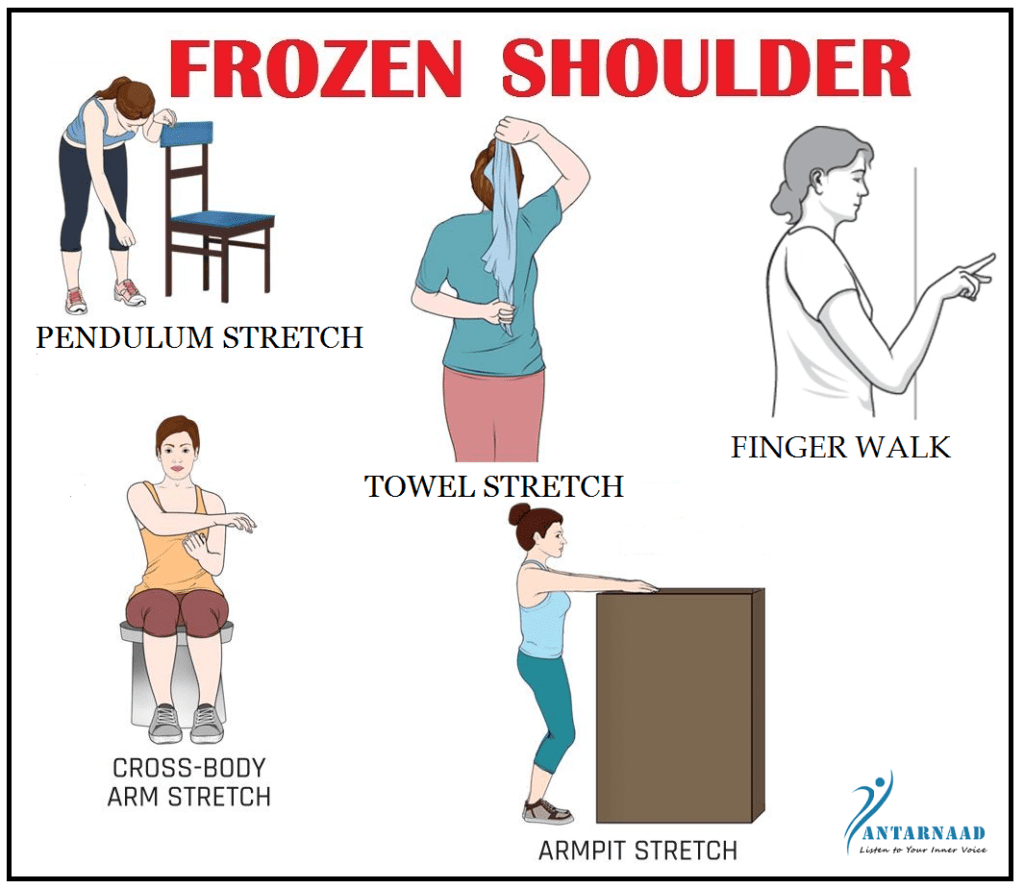
Before embarking on frozen shoulder exercises, it’s advisable to consult with a physical therapist or healthcare professional. They can provide tailored guidance, ensuring that the exercises align with individual needs.
Frozen Shoulder Exercises by Dr Sharad Gupta in Kanpur

Dr. Sharad Gupta in Kanpur is pioneering a revolution in the treatment of frozen shoulder, a condition that renders the shoulder stiff and painful. With a regimen grounded in meticulous research and evidence-based practices, Dr. Gupta’s frozen shoulder exercises are offering a beacon of hope to patients.
Frozen shoulder, medically known as adhesive capsulitis, typically involves a gradual onset of pain and a subsequent loss of movement. Dr. Sharad Gupta’s approach to managing this debilitating condition begins with an accurate diagnosis followed by a tailored exercise program that addresses the specific needs of each patient.
His exercise protocol typically includes gentle stretching to ease the joint capsule, strengthening exercises to fortify the muscles surrounding the shoulder, and mobility drills to restore range of motion. These exercises, when performed consistently and correctly, have been shown to alleviate pain and improve shoulder function significantly.
Patients in Kanpur have the advantage of accessing Dr. Sharad Gupta’s expertise in person. Under his guidance, they are educated about their condition and learn how to perform exercises with proper form and technique. This personalized touch not only enhances the effectiveness of the treatment but also empowers patients in their journey to recovery.
Dr. Sharad Gupta’s commitment to his patients is unwavering, and his frozen shoulder exercises are more than just movements; they are a testament to his dedication to restoring health and improving the quality of life for those suffering from this challenging condition.
When to Seek Professional Help with Frozen Shoulder Exercises
While frozen shoulder exercises can be a beacon of hope for many, they aren’t a one-size-fits-all solution. Understanding when it’s time to seek professional help is just as crucial as the exercises themselves. Here’s a guide to help you make an informed decision.
1. Persistent Pain
Engaging in frozen shoulder exercises can naturally result in some level of discomfort. However, if you notice the pain intensifying or persisting longer than expected, it’s a clear sign that professional intervention may be required. Pain is the body’s way of signaling distress; don’t overlook it.
2. Lack of Progress
Consistency in exercises is expected to yield results over time. If you’ve been dedicatedly following your regimen but witnessed no improvements or, worse, a regression in mobility, it’s time to consult an expert.
3. Swelling or Bruising
Post-exercise swelling or unusual bruising is not a typical response. If you encounter such symptoms, they could indicate deeper issues that need a professional’s attention.
Maintaining Shoulder Health: Tips and Tricks
Beyond frozen shoulder exercises, maintaining overall shoulder health is essential to prevent future issues and enjoy an active, pain-free lifestyle.
1. Stay Active
Regular physical activity, like walking or light aerobics, can help maintain joint flexibility. The key is to find a balance between rest and movement.
2. Good Posture is Crucial
Whether you’re sitting, standing, or sleeping, maintaining good posture ensures even weight distribution, preventing undue stress on the shoulder muscles and joints.
3. Avoid Repetitive Movements
Tasks that require repetitive shoulder movements, like painting ceilings or certain sports, can strain the shoulder. If these activities are unavoidable, ensure you take regular breaks.
4. Embrace Gentle Stretches
Even on good days, indulge in gentle shoulder stretches. This proactive approach can help in warding off potential shoulder ailments.
Thawing Your Way to Better Mobility with Frozen Shoulder Exercises
A frozen shoulder can feel like nature’s cruel irony – a joint designed for movement, stuck in place, causing discomfort and limiting our actions. The metaphor of “coldness” not only hints at the immobility but also the sudden and unwelcome onset of this condition. However, as with most challenges in life, there’s a silver lining. With consistent effort, patience, and the right set of frozen shoulder exercises, one can reclaim the full range of shoulder movement and bid goodbye to pain.
1. The Power of Persistence
It’s natural to feel discouraged when faced with limited mobility, especially in such a pivotal joint. However, the key lies in persistence. Regularly practicing frozen shoulder exercises can significantly speed up the thawing process. Like melting ice, it might not be evident instantly, but with time, the results become palpable.
2. Choosing the Right Exercises
There’s no shortage of exercises out there, but it’s essential to choose those tailored for frozen shoulders. Whether it’s gentle pendulum swings, towel stretches, or external rotations, selecting the right exercises ensures targeted relief and faster recovery.
3. Celebrate Small Wins
Every extra degree of movement achieved is a victory. Celebrating these small milestones can be a great morale booster, reminding you that progress is being made, one step at a time.
4. Life Beyond Pain
Imagine a day when reaching for that top shelf or waving to a friend isn’t accompanied by a wince of pain. That’s the goal! And with consistent frozen shoulder exercises, it’s an attainable one.
Stretching Exercises for Frozen Shoulder
Dr. Sharad Gupta is renowned in Kanpur for his expertise in treating frozen shoulders through targeted stretching exercises. His personalized approach includes a regimen of stretching exercises for frozen shoulders, carefully designed to increase range of motion and alleviate pain. Dr. Gupta’s methods are based on the latest research and his extensive experience, ensuring patients receive the most effective treatment. His dedication to rehabilitation and patient education makes him the preferred choice for those suffering from frozen shoulder, seeking relief and a return to normal functionality.
How to Stretch Frozen Shoulder
Dr. Sharad Gupta excels in educating patients on how to stretch frozen shoulder effectively. His clinic in Kanpur is equipped with the necessary tools and knowledge to guide patients through specific exercises tailored to their condition. Emphasizing the importance of gentle stretching exercises, Dr. Gupta helps patients safely increase their shoulder mobility, reducing stiffness and discomfort. His patient-centric approach and commitment to using evidence-based practices place him at the forefront of frozen shoulder treatment in the region.
Armpit Stretch for Frozen Shoulder
The armpit stretch is a critical component of Dr. Sharad Gupta’s treatment plan for patients with frozen shoulders in Kanpur. Recognizing the importance of this specific exercise, he meticulously instructs patients on its proper execution, ensuring they gain maximum benefit without risking further injury. Dr. Gupta’s comprehensive treatment plans, which include frozen shoulder exercises like the armpit stretch, demonstrate his holistic approach to physiotherapy, garnering him a reputation as the leading physiotherapy doctor in Kanpur for shoulder rehabilitation.
Pendulum Stretch for Frozen Shoulder
Dr. Sharad Gupta advocates the pendulum stretch for frozen shoulder as a fundamental exercise in restoring shoulder mobility. In Kanpur, his clinic is a hub for those seeking specialized care, where Dr. Gupta’s expertise in guiding patients through the pendulum stretch and other frozen shoulder exercises sets him apart. His focus on individualized treatment plans that incorporate such exercises ensures patients experience significant improvements in pain and range of motion, cementing his status as the top physiotherapy professional in the area.
Frozen Arm Exercises
Specializing in frozen arm exercises, Dr. Sharad Gupta provides comprehensive treatment for frozen shoulder sufferers in Kanpur. His tailored exercise programs, which include a variety of frozen arm exercises, are designed to address the unique needs of each patient, promoting healing and restoring function. Dr. Gupta’s approach to physiotherapy, characterized by empathy, expertise, and evidence-based practice, makes his clinic the go-to destination for individuals looking to overcome the challenges of frozen shoulder through dedicated exercises and rehabilitation.
FAQs
How long does a frozen shoulder typically last?
It can last anywhere from one to three years. However, with proper care and exercise, symptoms can improve much faster.
Is it advisable to exercise a frozen shoulder daily?
Yes, but it’s crucial to listen to your body and not push too hard. Always consult with a healthcare professional.
When is the best time to perform frozen shoulder exercises?
Warm-ups followed by exercises can be done in the morning to reduce stiffness or any time during the day when pain is minimal.
Are there any specific foods or diets that can help with shoulder recovery?
A balanced diet rich in omega-3 fatty acids, vitamins, and minerals can support overall joint health. Regular stretches and maintaining shoulder health can significantly reduce the chances of recurrence.
- कानपुर में गठिया रोग स्पेशलिस्ट डॉक्टर – Modern Treatment Without Surgery - September 9, 2025
- Chakkar Aane का इलाज- Kanpur के Advanced Clinic में! - September 8, 2025
- Heal, Strengthen, Thrive: Dr. Sharad Gupta, Kanpur’s #1 - October 12, 2024

